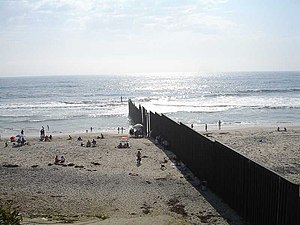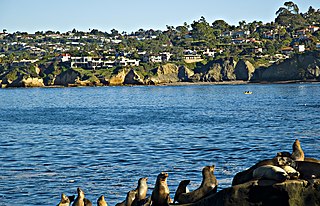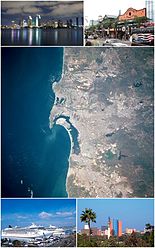
Tijuana is the largest city in the state of Baja California located on the northwestern Pacific Coast of Mexico. Tijuana is the municipal seat of the Tijuana Municipality and the hub of the Tijuana metropolitan area. It has a close proximity to the Mexico–United States border, which is part of the San Diego-Tijuana metro area.

Rosarito is a coastal city in Playas de Rosarito Municipality, Baja California, on the Pacific Coast of Mexico. As of 2010, the city had a population of 65,278. Located 10 miles (16 km) south of the US-Mexico border, Rosarito is a part of the greater San Diego–Tijuana region and one of the westernmost cities in Mexico. Rosarito is a major tourist destination, known for its beaches, resorts, and events like Baja Beach Fest.

The municipality of Ensenada is the fourth-largest municipality in Mexico with a land area of 19,526.8 km2 (7,539.3 sq mi) in 2020, about the same size as Hidalgo state and larger than five Mexican states.

Federal Highway 1 is a free (libre) part of the federal highway corridors of Mexico, and the highway follows the length of the Baja California Peninsula from Tijuana, Baja California, in the north to Cabo San Lucas, Baja California Sur, in the south. The road connects with Via Rapida, which merges into the American Interstate 5 (I-5) at the San Ysidro Port of Entry, which crosses the international border south of San Ysidro, California.

Tijuana Municipality is a municipality in the Mexican state of Baja California. Its municipal seat is located in the city of Tijuana. According to the 2020 census, the municipality had a population of 1,922,523. Montserrat Caballero of the MORENA is the current mayor. The municipality comprises the largest part of the Tijuana metropolitan area.

Playas de Rosarito Municipality is located in the northwestern part of the Mexican state of Baja California comprising part of the Tijuana metropolitan area. It lies just south of the city of Tijuana. Its municipal seat is the city of Rosarito. According to the 2020 census, the municipality had a population of 126,890 inhabitants. Its area is 513.32 km².

XESDD-AM or La Tremenda is a radio station in Tijuana, Baja California, Mexico. It broadcasts on 1030 kHz from a site along Mexican Federal Highway 1 near Puerto Nuevo in Playas de Rosarito Municipality, shared with sister station XESS-AM 620.

Metropolitan areas of Mexico have been traditionally defined as the group of municipalities that heavily interact with each other, usually around a core city, in Mexico. The phenomenon of metropolization in Mexico is relatively recent, starting in the 1940s. Because of an accelerated level of urbanization in the country, the definition of a metropolitan area is reviewed periodically by the Mexican population and census authorities.
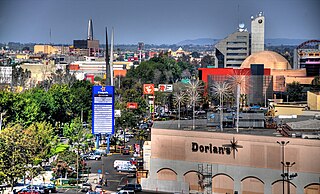
Zona Río is an official zone, and the main modern business district, of the city of Tijuana, Mexico.
Federal Highway 1D is a tolled part of the Mexico Federal Highways, paralleling Fed. 1. There are two segments, one in the state of Baja California and another in the state of Baja California Sur.
Mexicoach is a private transportation operator that provides cross-border service in the San Diego–Tijuana metropolitan area. The company has been in existence since 1970, with the main purpose of allowing day trippers to avoid the one-mile walk between customs and the Avenida Revolución. In recent years, the service's draw has been to avoid the long lines at the port of entry, which have plagued both vehicular and foot travellers, because Mexicoach passes between the two nations in a special clearance lane.
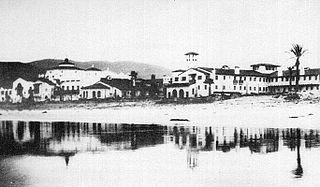
The Hotel Riviera del Pacífico was a hotel located in Ensenada, Baja California, Mexico. It was one of the most prestigious and luxurious hotels in Mexico.
Transportation in San Diego–Tijuana occurs by various means. Though, in the four cities of San Diego, Tijuana, Tecate, and Rosarito Beach, the automobile serves as most important means of transportation. The international metropolitan region maintains an intricate highway infrastructure. As a large metropolitan area in Western North America, many roadways, including Interstates, State Routes, and Mexican Federal Highways, hold a terminus in the area. These roads have grown accustomed to support the masses of the commuting populace within the international region and are constantly being expanded and/or renovated. Transportation is a crucial issue in the metropolitan area. The streets and highways of the region affect environmental health and have influence over the degree of regional connectivity. Binational discussions about coordinating public transportation across the border are currently underway. San Diego–Tijuana is the site of two major international airports and numerous regional airports. It is also the site of the Port of San Diego and miles from the nearby Port of Ensenada.
Corredor Tijuana-Rosarito 2000, also Bulevar 2000, Boulevard 2000, Corredor 2000, is a freeway in northwestern Baja California connecting the Mesa de Otay area of eastern Tijuana with Rosarito Beach. 42 kilometres (26 mi) long, it runs along the southeastern edge of the developed area of metropolitan Tijuana and is considered a major infrastructure project in the state. The freeway was designed for traffic of 75,000 cars per day and to spur development of a half-million new residential units.

The Complejo Recreativo y Cultural La Guancha is a recreational complex in barrio Playa in Ponce, Puerto Rico, with family recreational and cultural facilities that opened on 23 June 1998. The highlight of the complex is the Paseo Tablado La Guancha, which is flanked by a beach, an observation tower, an amphitheater, and 24 open-air kiosks. It was developed during the administration of Mayor Rafael Cordero Santiago. In October 2017, after Hurricane Maria, it closed to the public to undergo repairs but, as of January 2020, when the area suffered severe damage due to the 2020 Puerto Rico earthquakes, no repairs had been made and, as of 17 June 2020, it remained closed. By late 2020 arrangements were made for the merchants that operated from waterfront kiosks to reopen their businesses out of provisional facilities at a temporary location away from the waterfront while reconstruction of the waterfront area takes place.


